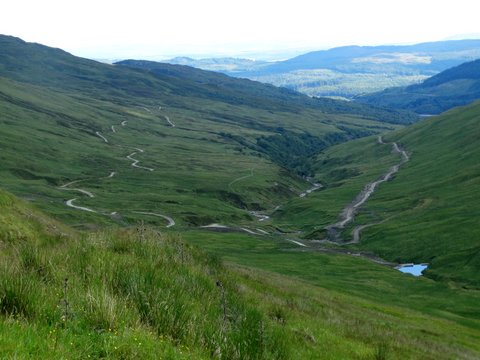
Gleann Casaig runs from the east shore of the Glen Finglas Reservoir, north of Brig O’Turk, up to the ridge between Ben Ledi and Ben Vane in the Trossachs. The glen forms part of the Woodland Trust’s Glen Finglas estate and part of the Great Trossachs Forest project which in 2015 was designated as Scotland’s newest and largest National Nature Reserve. It lies wholly within the Ben More and Ben Ledi Wild Land Area, where national policy indicates there should be a presumption against development. In December 2014, a few months after National Policy on Wild Land Areas had been issued, the Loch Lomond and Trossachs National Park Authority issued consent for the Allt Gleann Casaig hydro scheme.
The development has been completed much quicker than most (November 2016) and in July 2017 Jim Robertson, from the Munro Society, went out to have a look. Jim is helping co-ordinate the national survey of hydro schemes by Munro Society volunteers (see here – which explains the scheme and how you can get involved) and he used his visit to help trial the hydro scheme reporting form I helped the Munro Society develop. I have been meaning to blog about what he found ever since but meantime Jim has made another visit to check a couple of things. We have had a very good dialogue about this and while this post is based on what Jim has found, the opinions in it are solely my own.
Jim’s report (see here) – which is well worth reading – and photos show that most aspects of the design and restoration of this scheme have been done well.
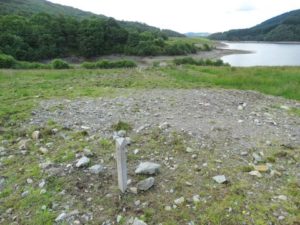

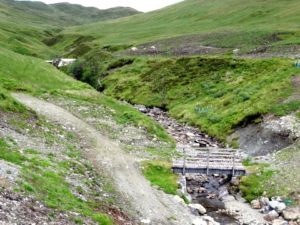
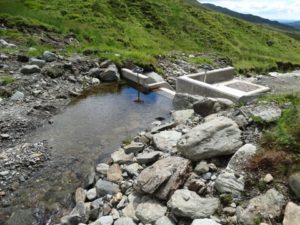
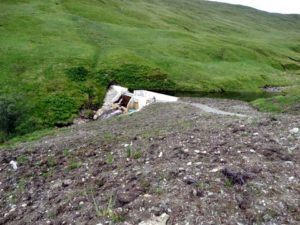
While some of the finishing of the development could be better (e.g the walls of the dam could have been disguised more and if you look carefully you will see yet another blue pipe, contrary to LLTNPA best practice design), I agree with Jim that generally the work on this scheme has been carried out to a high standard. Indeed, Jim was unable to identify to spot the other intakes which were included on the approved plan.
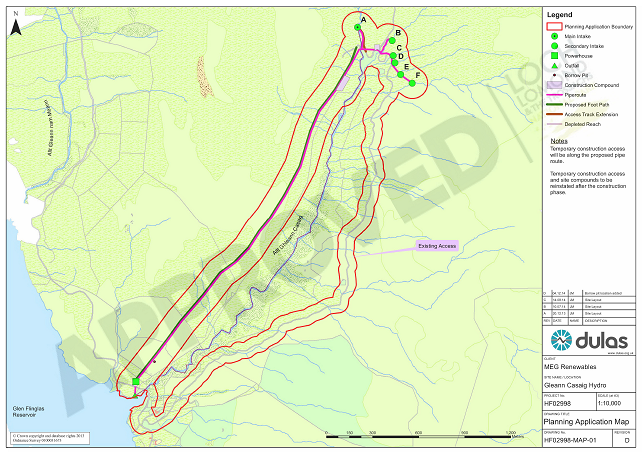
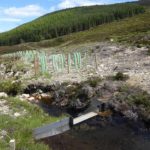
While it is possible the plan was amended post-consent – the LLTNPA is still refusing to publish documentation required by planning consents as a matter of course making it almost impossible for the public to understand what standards have been applied to each development and to report breaches of these – the plans showed intakes C-F were tiny (less than 1.5m broad) and therefore like the example left hard to see from any distance. In landscape terms if a concerned hillwalker cannot see these micro intakes or the lines of the pipes, that is a job well done.
The main concern about this development, as with most of the hydro schemes in the Loch Lomond and Trossachs National Park is the track which, as the top photo shows has a significant landscape impact.
The track which is supposed to be a footpath



In track construction terms, the new track up Gleann Casaig is in my view better than most and Jim commented its one of the best he has seen. The banks on the uphill side are not too steep and while sufficient vegetation was not retained to cover them, they should revegetate in time. Jim identified some poor finishing but this should not be that difficult to address and could be done without large machinery (which has all been moved off-site).
The problem though is that in planning terms (see here for all papers) this track is supposed to be a footpath and that the LLTNPA gave consent for a new footpath into a wild land area without any proper consideration of the impact on landscape or wild land . This “path” was not needed to provided access to the intakes because there was already a track up the Glen and the application included an extension of the existing track up to the main intake which was consented to by the LLTNPA:
Landscape and Visual Impact
A Landscape and Visual Impact Assessment (LVIA) was submitted in the ES. The consultation response from NP Landscape Adviser notes that existing access tracks will be used and extended to reach the intakes and the penstock route will be fully reinstated leaving a 2m wide new footpath to provide a circular route for recreational users. The Landscape Adviser agrees with the findings of the LVIA, that during construction there will be significant visual effect on Glen Casaig footpath and also during the operational period at The Mell near the powerhouse. The proposed mitigation would however reduce this over time. In terms of landscape effects the wooded upland glen is highly sensitive but no significant effects will result on this or the other LCT’s. (Extract from Report which approved the application)
The LLTNPA not only decided there would be no impact on the landscape – the top photo shows that this is NOT true – it also decided there would be no impact on wild land:
Impact on Wildland
The proposed development is located within the SNH Ben More ‐ Ben Ledi (Area 7) area of wild land and within the LLTNPA wildness buffer area, adjacent to an area of core wildness. An assessment in the ES states that the proposed development would not result in a reduction of the overall wild land quality. The introduction of new infrastructure – specifically the new footpath alongside the pipeline route, the new access track spur to the main intake and the intake structures themselves – must be considered alongside the presence of the existing access track through the glen. Appendix 5E of the ES sets out a number of mitigation measures during construction, as well as restoration and enhancement measures post construction. Provided these are implemented the development should integrate with the landscape and not detract from the special qualities of the wild land character.
The logic here appears to be that because there is already one track into a wild land area, that means there is no problem adding a second track. On this argument we would end up – and indeed are ending up – with tracks everywhere. The LLTNPA appears to be completely unaware of the Unna Principles governing the land Percy Unna bequeathed to the National Trust for Scotland which said there should be NO new footpaths into the hills and the subsequent heart searching which led to the current position where footpath work in hill areas on NTS is seen seen as being only justifiable in response to severe erosion. One might have hoped that our National Parks would support that position – indeed that has generally been the position in the Cairngorms – but instead the LLTNPA is consenting to new paths and tracks into Wild Land areas without any proper consultation or debate.
This failure to protect Wild Land was not helped by SNH’s response to the consultation which failed to make any mention of the Wild Land Area (see here) but left it to the LLTNPA to consider all the issues (despite the fact that it was SNH which drew up the excellent reports describing the special qualities of the wild land area).
While the LLTNPA consults the RSPB as a matter of course – in this case the RSPB drew the Park’s attention to Black Grouse leks which could have been affected by the development – they do not consult recreational organisations. Unless recreational organisations are alerted about developments which impact on Wild Land its impossible for them to keep up with what is going on and there were NO objections to this development. In my view our National Parks should consult all the main recreational and landscape interests about all developments affecting Wild Land (e.g Ramblers, Mountaineering Scotland, Scottish Campaign for National Parks – I am a member of all three) so they can comment on developments such as this.
The first thing the LLTNPA might have questioned was whether there was any demand for a circular route round the Glen.
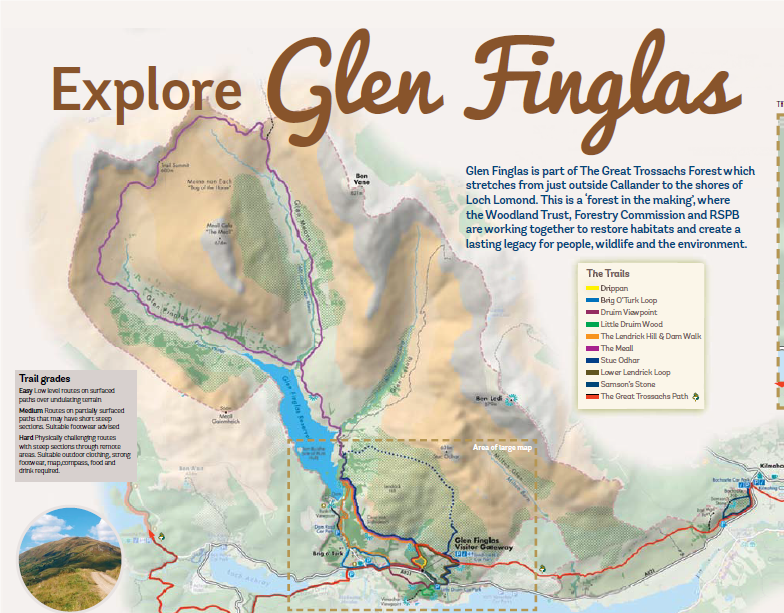
The LLTNPA could also have asked how the new circular route would fit into the network of tracks promoted by the Woodland Trust at Glen Finglas. The current leaflet on walks in Glen Finglas shows no routes round Glen Casaig (centre of map above). One wonders if the Developer ever talked to the Woodland Trust about this?
The other thing the LLTNPA could have questioned is why a path 2 metres wide was needed. Most paths into the hills, unless severely eroded, are far narrower than this so how does a 2m wide footpath fit with generally accepted standards for footpath construction?
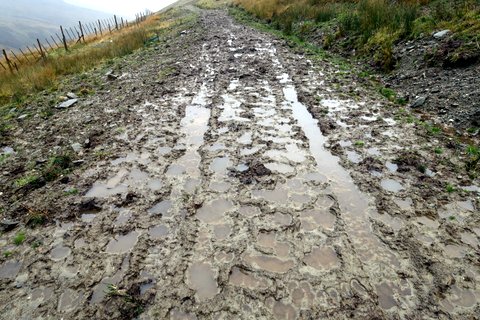
In the Report that approved the application the National Park access adviser is quoted as saying this:
“The development will bring benefits to public access through a new loop option and hopefully improved path surfacing. Final specifications for this new path need to be agreed.”
Whatever vision National Park staff had, its not been realised. The truth is this track was never intended as a footpath. Being 2m wide – in fact Jim has confirmed with me that the track is more than 2m wide in many places so does not even conform to the planning consent – it can still be used by vehicles and is, making the track totally unsuitable in walking for places.
There appear to be several possible explanations for why this “path” was proposed. The first is because it allows more direct access to the intakes than the older track up the Glen, which winds round the hill, and therefore takes more time. The second is that it could potentially assist with other aspects of estate management (e.g future tree planting planned as part of the Great Trossachs Forest) – if that is the case that should have been made clear. The third was it enabled the developer to save on restoration costs: so instead of fully restoring the ground above the pipeline, by including in the application a proposal for a 2m wide footpath the developer was able to reduce the amount of turf and soil it stored and reduced the amount of land it needed to restore. It seems to me that none of these reasons justify the retention of this track.
What needs to happen
While legally its too late now for the LLTNPA to require this track to be removed, it should take enforcement action to ensure that the restoration of the land around the track is the best possible standard and the track stops looking like a track and starts looking like a footpath. That means banning vehicles from using it. I am sure because the land is owned by the Woodland Trust, which should be more sensitive than most landowners to adverse publicity, that this should be possible (if any reader is a member of the WT please contact them and ask them to stop vehicle use of this track).
What Gleann Casaig and the Glen Feshie track prior notification covered in my last post show (see here) is that our National Parks are failing to consider properly developments which intrude into Wild Land areas. Our National Parks should be at the forefront of protecting wild land and developing best practice into how developments which impact on wild land should be treated. Instead, their actions are undermining the whole concept of Wild Land Areas. I believe there is an urgent need for both our National Parks to develop explicit policies to inform how they respond to developments in Wild Land area and that a key part of this should include consultation with recreation and landscape interests. The sad fact is that the LLTNPA in particular only stands up to developers if somebody objects to an application and therefore the best way to improve how they protect Wild Land is to ensure the public are aware of all such developments through recreation and landscape organisations.
I would also like to see that where our National Parks do consent to new paths or tracks, they include conditions about how they are used. These should include presumptions against motorised vehicles using new paths and also conditions forbidding vehicles from going off track. This would prevent the “track-creep” we see in both our National Parks where new tracks, instead of stopping vehicle erosion, simply open up new areas to vehicular use and all the damage that creates.

Another excellent, if disheartening, report. Having recently trudged along the abominable Gleann Cia-Aig track above Loch Arkaig – Armageddon, no more, no less – I would agree that while this scheme is indeed less intrusive than most I have seen, it is no excuse for letting the developer get away with swapping a footpath for a single-track road.